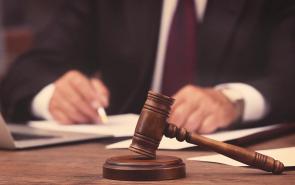
There are 93 United States Attorney offices in the United States, Puerto Rico, the U.S. Virgin Islands, Guam, and the Northern Mariana Islands. In each judicial district, one United States Attorney is assigned, except for Guam and the Northern Mariana Islands, where a single United States Attorney serves both districts. Under the guidance of the United States Attorneys' Manual, every United States Attorney is responsible for overseeing federal law enforcement within his or her particular jurisdiction. As many as 350 Assistant U.S. Attorneys (AUSAs) and 350 support staff work in district offices.
Assistant United States Attorneys (AUSAs), or federal prosecutors, are public officials who represent the federal government on behalf of the United States Attorney (USA) in criminal prosecutions, as well as in certain civil cases as either plaintiffs or defendants. The functions of AUSAs include investigating persons, issuing subpoenas, filing formal criminal charges, negotiating with defendants, and granting immunity to witnesses and accused criminals.
The Department of Justice is responsible for hiring and overseeing U.S. Attorneys. United States attorneys receive oversight, supervision, and administrative support from the United States Attorney Executive Office. US Attorneys who take part in the Advisory Committee of US Attorneys of the Attorney General.
History and Statutory Authority
The United States Attorney's Office, along with the Attorney General and Marshals service, was created as part of the Judiciary Act of 1789. A number of other court structures, including a district court system, were also specified in the same act as the Supreme Court structure. The Justice Department is thus older than the Office of United States Attorney. The Judiciary Act of 1789 provided for the appointment in each judicial district of a "Person learned in the law to act as attorney for the United States...whose duty it shall be to prosecute in each district all delinquents for crimes and offenses cognizable under the authority of the United States, and all civil actions in which the United States shall be concerned..." US Attorneys were independent of the Attorney General before 1870 when the Department of Justice was established. They were not subject to the AG's supervision or authority before then.
Appointment
U.S. Attorneys are appointed by the President of the United States for a four-year term, subject to confirmation by the Senate. U.S. Attorneys serve until their successors are appointed and qualified, beyond the term of their appointment. Unless the President directs otherwise, each U.S. attorney can be removed from office. A vacancy in the U.S. Attorney's position can be filled by appointment of the Attorney General since 1986.
Role of U.S. Attorneys
The United States Attorney is both the principal representative and the administrative head of the Office of the United States Attorney for the district. The U.S. Attorney's Office (USAO) prosecutes criminal cases on behalf of the United States and litigates civil cases as either a defendant or plaintiff. The United States may be represented in court by more than one lawyer. Under certain conditions, the United States can be represented by any citizen of the United States, with an attorney by their side, in an action called a qui tam lawsuit.
U.S. Attorneys serve as chief federal law enforcement officers and are in charge of all federal law enforcement personnel in their districts; they may direct them to engage in investigations, cease them, or assist them. For example, the FBI has been in charge of assets under the Department of Justice, including the Bureau of Alcohol, Tobacco, and Firearms and the Drug Enforcement Administration. U.S. Attorneys are also working with law enforcement agencies not affiliated with the Department of Justice to prosecute cases within their jurisdiction.
In addition to prosecuting cases in the District of Columbia Superior Court, the United States Attorney's office has the responsibility of prosecuting local criminal cases in the capital's municipal court. A federal Article I court, the Superior Court is located in Washington, D.C.
Executive Office for United States Attorneys
The United States Attorneys' Executive Office for United States Attorneys (EOUSA), which is comprised of 93 United States Attorneys and 94 U.S. Attorneys' offices (Guam and the Northern Mariana Islands have one U.S. Attorney each), provides the following services:
- General executive assistance and direction,
- Policy development,
- Administrative management direction and oversight,
- Operational support,
- Coordination with other components of the United States Department of Justice and other federal agencies.
Legal education, budgeting, administrative, and personnel services are included in these responsibilities.
The EOUSA was created on April 6, 1953, by Attorney General Order No. 8-53 to provide for close liaison between the Department of Justice in Washington, DC, and the 93 U.S. attorneys located throughout the 50 states, the District of Columbia, Guam, the Northern Mariana Islands, Puerto Rico, and the U.S Virgin Islands. James R. Browning, a judge on the Ninth Circuit Court of Appeals, organized the organization.
The Mission of the US Attorneys Office
The U.S. Attorneys collaborate with the Attorney General to prosecute crimes throughout the country. Criminal prosecutions are brought by their offices, civil penalties are pursued, federal programs are defended, and the financial interests of the United States are protected. As well as advising the Attorney General and senior policy leaders through its various subcommittees, the Advisory Committee provides advice and counsel. Executive Office for U.S Attorneys (EOUSA) provides support for the Department of Justice and other federal agencies through general executive assistance and direction, policy development, administrative management direction, and training.
Trials that involve the United States are usually handled by United States Attorneys. Section 547 of Title 28 of the United States Code gives United States Attorneys three statutory responsibilities:
- the prosecution of criminal cases brought by the Federal Government;
- the prosecution and defense of civil cases in which the United States is a party; and
- the collection of debts owed the Federal Government which are administratively uncollectible.
In spite of the vast differences in caseloads between districts, all US Attorneys' Offices handle a variety of simple and complex cases. US Attorneys have a great deal of discretion in how they utilize their resources to advance their local jurisdictions' priorities and needs.
List of Current U.S. Attorneys' Offices
- U.S. Attorney for the Middle District of Alabama
- U.S. Attorney for the Northern District of Alabama
- U.S. Attorney for the Southern District of Alabama
- U.S. Attorney for the District of Alaska
- U.S. Attorney for the District of Arizona
- U.S. Attorney for the Eastern District of Arkansas
- U.S. Attorney for the Western District of Arkansas
- U.S. Attorney for the Central District of California
- U.S. Attorney for the Eastern District of California
- U.S. Attorney for the Northern District of California (USAO)
- U.S. Attorney for the Southern District of California
- U.S. Attorney for the District of Colorado
- U.S. Attorney for the District of Columbia
- U.S. Attorney for the District of Connecticut
- U.S. Attorney for the District of Delaware
- U.S. Attorney for the Middle District of Florida (USAO)
- U.S. Attorney for the Northern District of Florida
- U.S. Attorney for the Southern District of Florida (USAO)
- U.S. Attorney for the Middle District of Georgia
- U.S. Attorney for the Northern District of Georgia
- U.S. Attorney for the Southern District of Georgia
- U.S. Attorney for the Districts of Guam and the Northern Mariana Islands (USAO)
- U.S. Attorney for the District of Hawaii (USAO)
- U.S. Attorney for the District of Idaho
- U.S. Attorney for the Central District of Illinois
- U.S. Attorney for the Northern District of Illinois
- U.S. Attorney for the Southern District of Illinois
- U.S. Attorney for the Northern District of Indiana (USAO)
- U.S. Attorney for the Southern District of Indiana
- U.S. Attorney for the Northern District of Iowa
- U.S. Attorney for the Southern District of Iowa (USAO)
- U.S. Attorney for the District of Kansas
- U.S. Attorney for the Eastern District of Kentucky
- U.S. Attorney for the Western District of Kentucky
- U.S. Attorney for the Eastern District of Louisiana
- U.S. Attorney for the Middle District of Louisiana
- U.S. Attorney for the Western District of Louisiana
- U.S. Attorney for the District of Maine
- U.S. Attorney for the District of Maryland (USAO)
- U.S. Attorney for the District of Massachusetts
- U.S. Attorney for the Eastern District of Michigan
- U.S. Attorney for the Western District of Michigan
- U.S. Attorney for the District of Minnesota
- U.S. Attorney for the Northern District of Mississippi
- U.S. Attorney for the Southern District of Mississippi
- U.S. Attorney for the Eastern District of Missouri
- U.S. Attorney for the Western District of Missouri
- U.S. Attorney for the District of Montana
- U.S. Attorney for the District of Nebraska
- U.S. Attorney for the District of Nevada
- U.S. Attorney for the District of New Hampshire
- U.S. Attorney for the District of New Jersey (USAO)
- U.S. Attorney for the District of New Mexico
- U.S. Attorney for the Eastern District of New York (USAO)
- U.S. Attorney for the Northern District of New York (USAO)
- U.S. Attorney for the Southern District of New York (USAO)
- U.S. Attorney for the Western District of New York (USAO)
- U.S. Attorney for the Eastern District of North Carolina
- U.S. Attorney for the Middle District of North Carolina
- U.S. Attorney for the Western District of North Carolina
- U.S. Attorney for the District of North Dakota
- U.S. Attorney for the Northern District of Ohio
- U.S. Attorney for the Southern District of Ohio
- U.S. Attorney for the Eastern District of Oklahoma
- U.S. Attorney for the Northern District of Oklahoma
- U.S. Attorney for the Western District of Oklahoma (USAO)
- U.S. Attorney for the District of Oregon
- U.S. Attorney for the Eastern District of Pennsylvania
- U.S. Attorney for the Middle District of Pennsylvania
- U.S. Attorney for the Western District of Pennsylvania
- U.S. Attorney for the District of Puerto Rico
- U.S. Attorney for the District of Rhode Island
- U.S. Attorney for the District of South Carolina
- U.S. Attorney for the District of South Dakota (USAO)
- U.S. Attorney for the Eastern District of Tennessee
- U.S. Attorney for the Middle District of Tennessee
- U.S. Attorney for the Western District of Tennessee
- U.S. Attorney for the Eastern District of Texas
- U.S. Attorney for the Northern District of Texas
- U.S. Attorney for the Southern District of Texas
- U.S. Attorney for the Western District of Texas
- U.S. Attorney for the District of Utah
- U.S. Attorney for the District of Vermont
- U.S. Attorney for the District of the Virgin Islands
- U.S. Attorney for the Eastern District of Virginia
- U.S. Attorney for the Western District of Virginia
- U.S. Attorney for the Eastern District of Washington
- U.S. Attorney for the Western District of Washington
- U.S. Attorney for the Northern District of West Virginia
- U.S. Attorney for the Southern District of West Virginia
- U.S. Attorney for the Eastern District of Wisconsin
- U.S. Attorney for the Western District of Wisconsin
- U.S. Attorney for the District of Wyoming
United States Attorney General
U.S. attorney general (AG) heads the Department of Justice and is the chief lawyer for the federal government of the United States. On all legal matters, the attorney general serves as the president's principal advisor. Attorneys general is statutory members of the Cabinet of the United States.
The U.S. Constitution's Appointments Clause requires the president to nominate the person for the office, and the United States Senate to confirm him or her. Several deputy attorneys general work in the Attorney General's Office.
Since March 11, 2021, Merrick Garland has been the United States attorney general.
For Assistant United States Attorney Jobs
Related Articles to read:
- Can I Move to a Government Job then Come Back to a Law Firm?
- Litigation, Legal Practice Area
- Why Lateraling as an Attorney Makes Sense
- The Number One Reason You Are Not Getting the Jobs You Want and May Be Unsatisfied in Your Legal Career
- For Legal Internships That Were More Than Five Years Ago, Should They Be Listed (e.g., 2011 to 2013)?
- 100+ of the Toughest Interview Questions Law Firm Ask Attorneys and Law Students and How to Answer Them
- Top 6 Things Attorneys and Law Students Need to Remove from Their Resumes ASAP
About Harrison Barnes
Harrison Barnes is a prominent figure in the legal placement industry, known for his expertise in attorney placements and his extensive knowledge of the legal profession.
With over 25 years of experience, he has established himself as a leading voice in the field and has helped thousands of lawyers and law students find their ideal career paths.
Barnes is a former federal law clerk and associate at Quinn Emanuel and a graduate of the University of Chicago College and the University of Virginia Law School. He was a Rhodes Scholar Finalist at the University of Chicago and a member of the University of Virginia Law Review. Early in his legal career, he enrolled in Stanford Business School but dropped out because he missed legal recruiting too much.
Barnes' approach to the legal industry is rooted in his commitment to helping lawyers achieve their full potential. He believes that the key to success in the legal profession is to be proactive, persistent, and disciplined in one's approach to work and life. He encourages lawyers to take ownership of their careers and to focus on developing their skills and expertise in a way that aligns with their passions and interests.
One of how Barnes provides support to lawyers is through his writing. On his blog, HarrisonBarnes.com, and BCGSearch.com, he regularly shares his insights and advice on a range of topics related to the legal profession. Through his writing, he aims to empower lawyers to control their careers and make informed decisions about their professional development.
One of Barnes's fundamental philosophies in his writing is the importance of networking. He believes that networking is a critical component of career success and that it is essential for lawyers to establish relationships with others in their field. He encourages lawyers to attend events, join organizations, and connect with others in the legal community to build their professional networks.
Another central theme in Barnes' writing is the importance of personal and professional development. He believes that lawyers should continuously strive to improve themselves and develop their skills to succeed in their careers. He encourages lawyers to pursue ongoing education and training actively, read widely, and seek new opportunities for growth and development.
In addition to his work in the legal industry, Barnes is also a fitness and lifestyle enthusiast. He sees fitness and wellness as integral to his personal and professional development and encourages others to adopt a similar mindset. He starts his day at 4:00 am and dedicates several daily hours to running, weightlifting, and pursuing spiritual disciplines.
Finally, Barnes is a strong advocate for community service and giving back. He volunteers for the University of Chicago, where he is the former area chair of Los Angeles for the University of Chicago Admissions Office. He also serves as the President of the Young Presidents Organization's Century City Los Angeles Chapter, where he works to support and connect young business leaders.
In conclusion, Harrison Barnes is a visionary legal industry leader committed to helping lawyers achieve their full potential. Through his work at BCG Attorney Search, writing, and community involvement, he empowers lawyers to take control of their careers, develop their skills continuously, and lead fulfilling and successful lives. His philosophy of being proactive, persistent, and disciplined, combined with his focus on personal and professional development, makes him a valuable resource for anyone looking to succeed in the legal profession.
About BCG Attorney Search
BCG Attorney Search matches attorneys and law firms with unparalleled expertise and drive, while achieving results. Known globally for its success in locating and placing attorneys in law firms of all sizes, BCG Attorney Search has placed thousands of attorneys in law firms in thousands of different law firms around the country. Unlike other legal placement firms, BCG Attorney Search brings massive resources of over 150 employees to its placement efforts locating positions and opportunities its competitors simply cannot. Every legal recruiter at BCG Attorney Search is a former successful attorney who attended a top law school, worked in top law firms and brought massive drive and commitment to their work. BCG Attorney Search legal recruiters take your legal career seriously and understand attorneys. For more information, please visit www.BCGSearch.com.
Harrison Barnes does a weekly free webinar with live Q&A for attorneys and law students each Wednesday at 10:00 am PST. You can attend anonymously and ask questions about your career, this article, or any other legal career-related topics. You can sign up for the weekly webinar here: Register on Zoom
Harrison also does a weekly free webinar with live Q&A for law firms, companies, and others who hire attorneys each Wednesday at 10:00 am PST. You can sign up for the weekly webinar here: Register on Zoom
You can browse a list of past webinars here: Webinar Replays
You can also listen to Harrison Barnes Podcasts here: Attorney Career Advice Podcasts
You can also read Harrison Barnes' articles and books here: Harrison's Perspectives
Harrison Barnes is the legal profession's mentor and may be the only person in your legal career who will tell you why you are not reaching your full potential and what you really need to do to grow as an attorney--regardless of how much it hurts. If you prefer truth to stagnation, growth to comfort, and actionable ideas instead of fluffy concepts, you and Harrison will get along just fine. If, however, you want to stay where you are, talk about your past successes, and feel comfortable, Harrison is not for you.
Truly great mentors are like parents, doctors, therapists, spiritual figures, and others because in order to help you they need to expose you to pain and expose your weaknesses. But suppose you act on the advice and pain created by a mentor. In that case, you will become better: a better attorney, better employees, a better boss, know where you are going, and appreciate where you have been--you will hopefully also become a happier and better person. As you learn from Harrison, he hopes he will become your mentor.
To read more career and life advice articles visit Harrison's personal blog.





